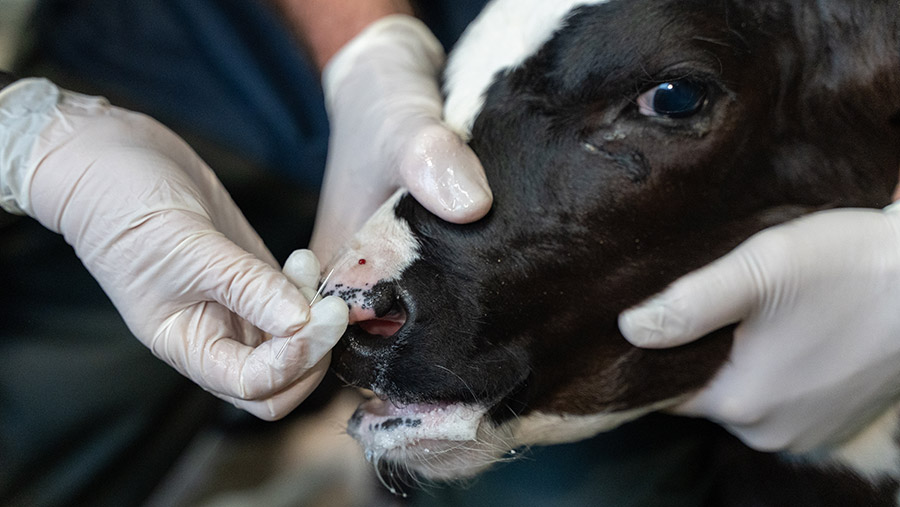Blood test shows colostrum immunity worth £78 a head
 Capillary tube being used to take calf blood sample © Bimeda
Capillary tube being used to take calf blood sample © Bimeda Dairy units could be rewarded for batches of calves with sufficient blood immunoglobulin levels, with one finisher valuing the difference at £78 in feed cost.
A blood test for immunoglobulin G (IgG) in young calves will be used as “a carrot rather than a stick” by dairy-beef integrators, Farmers Weekly understands.
Dairy beef integrator Adam Buitelaar has said a bonus for calves (soon to be decided) with more than 15ml/ml of IgG in their blood, as an indicator of successful passive transfer of immunity, is imminent for its supplying dairy.
See also: Guide to feeding newborn calves colostrum
Bonus rollout
Adam Buitelaar, who worked with Synergy Farm Health and Soma Bioscience to develop the test, said Buitelaar plans to pay bonuses to farmers on “correct results” very soon.
He said Buitelaar would use the test to reward good practice and discuss where improvements might be needed.
“It is not only the fact that not enough colostrum is given to calves early enough, it’s the quality of colostrum that has a big part to play,” he added.
Early results
One farm is targeting testing at the smaller, weaker calves in a batch, to limit expense.
Early trial results show calves with sufficient IgGs have a lower average age to slaughter and a higher margin than those that fail the blood test for passive transfer.
This is according to Promar consultant George Peart, an adviser who has seen the feed savings benefits on one of his client’s farms.
Promar costings showed that saving 2.5 months on finishing was worth 811kg of feed (dry matter). For every six animals, enough feed was saved to finish another one at 22.5 months.
“The unit’s average age at slaughter is 22.5 months, but the calves without colostrum take 25 months,” said George.
“We have seen from our feed intake data that 2.5 months on finishing time is worth £78 a head and will be looking to average a slaughter age of 20 months this year to save that extra feed if possible.”
What colostrum means for beef performance
- Ingredients 92% grass silage, 8% barley
- Cost £96/t (dry matter basis)
- System Taking calves at about one week old, weaning onto rotational grazing and finishing on high-quality silage
- Genetics Dairy-cross genetics with a mix of native sires, including a T14 line, a cross of a US Simmental and a low-stature US Angus.
Dry matter intake and cost of three different finishing ages |
||
|
Age at slaughter |
Dry matter intake (kg) |
Feed cost |
|
25 months (lacking colostrum) |
5,478 |
£550 |
|
22.5 months (average) |
4,937 |
£472 (saves £78) |
|
20 months (target) |
4,061 |
£388 (saves £161) |
| Source: Promar | ||
How the test works
The pen-side blood test, called ImmunIGY (marketed by Bimeda), takes 10 minutes and works as follows:
- Calf’s nose is pricked at the top of the nasal plane.
- Small capillary tube (about 5cm long) collects blood.
- Blood sample, marked with calf’s identification, is placed in a buffer solution in a small bottle. The sample can be stored for a week at room temperature.
- The test produces a colour and a line. The colour corresponds to the IgG value, and the weaker the line, the higher the IgG.
- A small electronic reader is held over the line, giving the result as a number (mg/ml). This happens ten minutes after the three drops of sample have been applied to the reader.
- Cost The electronic reader is £400 and testing costs vary depending on order size.
- Advantages This test is faster than laboratory tests that rely on blood plasma, and it works up to 42 days of age, meaning calves can be tested when they are on rearing units. Some lab tests only worked up to five days of age.
Immunoglobulin test |
|||
|
Immunoglobulin levels on the ImmunIGY test for Immunoglobulin G |
|||
|
Age (days) |
Red status (low) |
Amber status (adequate) |
Green status (good) |
|
2-14 |
Less than 10mg/ml |
10-15mg/ml |
More than 15mg/ml |
|
14-42 |
Less than 7.5mg/ml |
7.5-12.5mg/ml |
More than 12.5mg/ml |
| Source: Bimeda | |||
